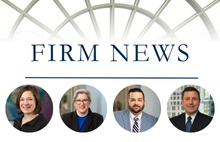Supreme Court Rules that Google’s Use of Java Source Code for Android Phone Is Permissible Fair Use
April 7, 2021On April 5, 2021, the U.S. Supreme Court ended a decade-long copyright dispute between two powerhouses of the computing world. In Google v. Oracle, the Court found by a 6-2 majority that Google’s use of certain portions of Oracle’s Java SE source code to develop a software platform for the Google Android smartphone was a fair use.
The federal Copyright Act generally prohibits copying even small portions of literary works, including computer source code. However, the Copyright Act also recognizes that for public policy reasons, certain types of copying should not be prohibited. One of the better-known of these is “fair use”: the idea that certain uses of copyrighted works, such as for criticism, comment, news reporting, teaching, scholarship, or research, should be permitted. Rather than define fair use, the Copyright Act enumerates four factors to determine whether a given use of copyrighted material is a fair use:
- the purpose of the use, including whether such use is of a commercial nature;
- the nature of the copyrighted work;
- the amount of the portion used in relation to the work as a whole; and
- the effect of the use upon the value of the copyrighted work.
The Google v. Oracle dispute arose as follows. In 1995, Sun Microsystems created the Java programming language, which was designed to have several advantages over then-dominant languages like C and C++. One of these advantages is that Java is “machine-independent”—its code can be written on one computer and yet function on virtually any other. To further facilitate this goal, Java includes an Application Programming Interface (API). This is a collection of pre-defined software modules that perform everyday computer functions (e.g., detecting where a mouse was clicked on the screen) and are used by software developers to create advanced applications without starting from scratch. By 2008, Java included 166 API packages with more than 30,000 “methods”—functions designed to be used without the programmer's having to know or understand the details of how they work.
Google initiated talks with Sun about licensing Java API for the new Android smartphone. However, the talks broke down when Sun objected to Google’s desire for an open and unfettered platform with few restrictions, because this would undermine interoperability. Google nonetheless proceeded to build its Android platform, copying roughly 11,500 lines of Java code that define a portion of the Java API (known as the “declaring code”) but creating its own “implementing code” to work with the copied portion, and began using the combined code in Android mobile phones without paying the licensing fee. Oracle (after purchasing Sun) eventually filed suit.
This case has a long and complex history, but for purposes of the Supreme Court’s decision, the issues had been narrowed to (1) whether APIs (and the declaring code as a portion thereof) are protected by copyright at all, and (2) whether Google’s use of the Java declaring code constituted a fair use. The majority expressed skepticism over the copyrightability of an API but ultimately declined to rule on that issue at all, finding by a 6-2 majority that, regardless of whether the API was copyrightable, Google’s use was a fair use. The majority examined the fair use factors as follows:
- Google’s copying of portions of Oracle’s API was necessary to operate in a new environment (smartphones) and, through its “transformative use” of the code (by the creation of its own implementing code), its actions were consistent with the “creative process” protected by the fair use doctrine, even where its acts were clearly commercial in nature;
- the copied code was effectively the “user interface,” such that its value was heavily derived from the time that computer programmers (who created implementing code) invested into learning Java, and therefore less subject to protection;
- although Google copied virtually all of the Java declaring code, this constituted only 0.04% of the entire Java code base, and though even a small amount of copying can be infringement when it is the “heart” of the original copyrighted work, it matters less when the material was copied purely to allow for Google programmers to create the Android platform within a known environment (Java); and
- Google’s Android is not a substitute for Java SE, and the enforcement of Oracle’s copyright (if it exists) would risk stifling creativity on software development without furthering the basic objective of copyright law.
Justices Thomas and Alito dissented, asserting that a finding of fair use would necessarily require a finding that the API in question was subject to copyright protection (which the majority passed on), and then contended that the majority’s logic for the fair use factors was motivated by an arbitrary distinction between “implementing code” and “declaring code” that is not countenanced by the text of the Copyright Act.
The net effect of the Supreme Court’s ruling is not immediately apparent, with the majority candidly acknowledging that the unique blend of expression and function in computer programs “makes it difficult to apply traditional copyright concepts in that technological world.” The decision firmly emphasized that the Court’s holding does not “overturn or modify the nature of those concepts” or “overturn or modify . . . earlier cases involving fair use” in other contexts.
Technology continues to push boundaries of the law, forcing everybody involved in the intellectual property development process to think carefully and critically. As this brief overview should make clear, copyright law and particularly application of the fair use doctrine is exceptionally complicated, especially in the area of computer programming. The intellectual property lawyers at Lewis Rice have experience in dealing with complex technology issues, including software development and source code protection. If you develop or license software or source code and have questions about your software or licenses, contact a Lewis Rice Intellectual Property lawyer.








